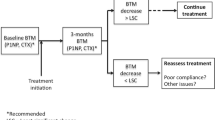Abstract
A comparative study was performed on the sensitivity of the determination of the available biochemical markers of bone formation — total and bone alkaline phosphatase (TAP and bAP, respectively), osteocalcin (BGP), procollagen I aminoterminal propeptide (PINP) and procollagen I carboxyterminal propeptide (PICP) — in the study of postmenopausal osteoporosis. The comparison between PINP and PICP, due to the recent development of the amino-terminal assay, is of special interest. The study included 26 untreated osteoporotic postmenopausal women, age 59±6 years (range 46–69 years) and 17 healthy control postmenopausal women, age 56±7 years (range 48–70 years). We found a significant increase in the levels of bAP (p=0.0021), BGP (p=0.041), PINP (p=0.0001) and PICP (p=0.0073), but not in the levels of TAP (p=0.3389), in osteoporotic patients with respect to the control group. Serum PINP and bAP showed the highest diagnostic accuracy among the markers of bone formation studied, as can be deduced from the receiver operating characteristics (ROC) curves. In spite of their similar origin (amino-terminal and carboxy-terminal release from a procollagen molecule), the results obtained by measuring levels of PINP are significantly better than those found with PICP.
Similar content being viewed by others
References
Delmas PD. Biochemical markers of bone remodeling in osteoporosis. In: Papapoulos SE, Lips P, Pols HAP, Johnston CC, Delmas PD, editors. Osteoporosis 96. International congress series 1118. Amsterdam: Elsevier, 1996:191–204.
Panigrahi K, Delmas PD, Singer F, et al. Characteristics of a two-site immunoradiometric assay for human skeletal alkaline phosphatase in serum. Clin Chem 1994;40:822–8.
Withold W, Schulte U, Reinauer H. Method for determination of bone alkaline phosphatase activity: analytical performance and clinical usefulness in patients with metabolic and malignant bone diseases. Clin Chem 1996;42:210–7.
Diaz Diego EM, Guerrero R, De la Piedra C. Six osteocalcin assays compared. Clin Chem 1994;40:2071–7.
Delmas PD, Christiansen C, Mann KG, Price PA. Bone Gla protein (osteocalcin) assay standardization report. J Bone Miner Res 1990;5:5–11.
Melkko J, Niemi S, Risteli L, Risteli J. Radioimmunoassay for the carboxyterminal propeptide of human type I procollagen (PICP). Clin Chem 1990;36:1328–32.
Melkko J, Kauppila S, Niemi S, Risteli L, Haukipuro K, Jukkola A, Risteli J. Immunoassay for the intact aminoterminal propeptide of human type I procollagen. Clin Chem 1996;42:947–54.
Zweig MH, Campbell G. Receiver-operating characteristic (ROC) plots: a fundamental evaluation tool in clinical medicine. Clin Chem 1993;39:561–77.
Delmas PD. Biochemical markers of bone turnover. J Bone Miner Res 1993; 8 (Suppl 2): S549–55.
Garnero P, Delmas PD. Assessment of the serum levels of bone alkaline phosphatase with a new immunoradiometric assay in patients with metabolic bone disease. J Clin Endocrinol Metab 1993;77:1046–53.
Masters PW, Jones RG, Purves DA, Cooper EH, Cooney JM. Commercial assays for serum osteocalcin give clinically discordant results. Clin Chem 1994;40:358–63.
Garnero P, Grimaux M, Seguin P, Delmas PD. Characterization of immunoreactive forms of human osteocalcin generated in vivo and in vitro. J Bone Miner Res 1994;9:255–64.
Parfitt AM, Simon LS, Villanueva AR, et al. Procollagen type I carboxy-terminal extension peptide in serum as a marker of collagen biosynthesis in bone: correlation with iliac bone formation rates and comparison with total alkaline phosphatase. J Bone Miner Res 1987;2:427–36.
Hasling C, Eriksen EF, Melkko J, Risteli L, Charles P, Moskilde L, Risteli J. Effects of a combined estrogen-gestagen regimen on serum levels of the carboxy-terminal propeptide of human type I procollagen in osteoporosis. J Bone Miner Res 1991;6:1295–300.
Davis BH, Madri JA. An immnohistochemical and serum ELISA study of type I and III procollagen aminopropeptides in primary biliary cirrhosis. Am J Pathol 1987;128:265–75.
Rasmussen HBB, Teisner B, Bangsgaard-Petersen F, Yde-Andersen E, Kassem M. Quantification of fetal antigen 2 (FA2) in supernatants of cultured osteoblasts, normal human serum, and serum from patients with chronic renal failure. Nephrol Dial Transplant 1992;7:902–7.
Ebelling PR, Peterson JM, Riggs BL. Utility of type I procollagen propeptide assays for assessing abnormalities in metabolic bone diseases. J Bone Miner Res 1992;7:1243–50.
Linkhart SG, Linkhart TA, Taylor AK, Wergedal JE, Bettica P, Baylink DJ. Synthetic peptide-based immunoassay for amino-terminal propeptide of type I procollagen: application for evaluation of bone formation. Clin Chem 1993;39:2254–8.
Risteli L. Marcadores óseos procedentes del colágeno tipo I: PICP, ICTP y PINP. Revista Española de Enfermedades Metabólicas Oseas 1996;5:81–5.
Author information
Authors and Affiliations
Rights and permissions
About this article
Cite this article
Cabrera, C.D., Henríquez, M.S., Traba, M.L. et al. Biochemical markers of bone formation in the study of postmenopausal osteoporosis. Osteoporosis Int 8, 147–151 (1998). https://doi.org/10.1007/BF02672511
Received:
Accepted:
Issue Date:
DOI: https://doi.org/10.1007/BF02672511




